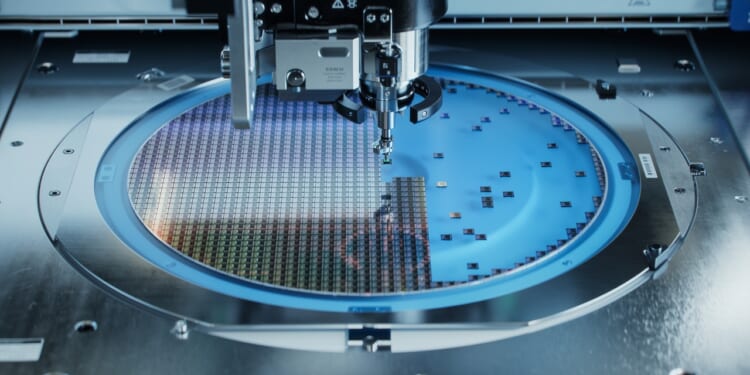Reverse-engineering lithography machines—the equipment on which advanced computer chips are manufactured—is not as straightforward as copying most industrial designs.
In the race between innovators and imitators, it is often the imitators who win out. That’s according to Ohio University business professor, Oded Shenkar, in his 2010 book Copycats: How Smart Companies Use Imitation to Gain a Strategic Edge. It applies equally to what Ted C. Fishman once described as “China, Inc.,” as it does to Apple or Samsung.
Over the last half-century, the People’s Republic of China (PRC) has transformed from an agrarian nation under a personalist dictatorship—in effect a large-scale North Korea—to the second-largest economy in gross domestic product (GDP) terms (and the largest economy in purchasing power parity, or PPP, terms). The transformation is remarkable. The methods it used to catch up to the West are less so.
Understanding China’s High-Tech Development
Part of China’s strength resides in its constantly evolving high-technology sector, borne in large part out of China’s advanced manufacturing capabilities. And while Chinese scientists and engineers are innovative and brilliant people, the Chinese high-tech and manufacturing sectors are only in existence because the United States and the wider West offloaded massive amounts of manufacturing capabilities.
In essence, once China became the world’s sweatshop, it moved up the development ladder, quickly building a high-tech production ecosystem to rival even that of the United States.
Fundamentally, however, the Chinese—like the imitator firms highlighted in Shenkar’s 2010 book mentioned above—have built their entire economy upon slashing onerous development cycles by pilfering and/or copying more advanced, innovative countries and foreign firms. As Taiwanese-born venture capitalist Kai-Fu Lee explained in his 2018 book AI Superpowers: China, Silicon Valley, and the New World Order, domestic Chinese tech firms steal and rip each other off with wanton abandon. It’s part of the culture there—with the only imperative being to create new technologies and products that will expand the bottom line and enhance the prestige and national security of China.
With that in mind, why should one expect Chinese tech firms to treat US and Western competitors with a greater level of respect than they have toward their own domestic rivals?
A Nation of Copycats Is Still a Threat
Because China has copied many of the baseline capabilities of the West to jumpstart their dynamic indigenous industries, the Chinese have serious bottlenecks that the West can—and has—exploit in times of geopolitical crises.
Since 2018, the United States has waged what’s known as the “Tech War” upon China as part of America’s larger trade war against the PRC. The Americans have imposed sanctions on high-end computer chips being sold to China. In retaliation, the Chinese have instituted strict controls over the rare earth minerals that are essential for the creation of those chips and other important high-technology, especially for the US military.
But the chip bans on China have had real consequences for China’s high-tech development. As the race for artificial intelligence dominance heats up between the two great powers, those high-end chip bans have complicated China’s ability to keep up with the Americans. They have forced China to get very creative in how it gains access to those chips.
What’s more, the US chip ban essentially freezes China’s ability to reliably develop its own high-end chip to older, larger chips (in the chip world, smaller is better). Dutch firm ASML creates the very expensive and complex chip fabricators that build the world’s computer chips.
Understanding America’s Big Semiconductor Play
Because of American sanctions, China has been relegated to older ASML Deep Ultraviolet (DUV) lithography systems—which, in turn, are stymying the ability for China to leapfrog the Americans in AI creation.
Interestingly, a source reports that in recent months, the Chinese have been caught trying to reverse-engineer the ASML DUV lithography machine. That’s not because the Chinese want to know how to mass produce these older machines. It’s because Chinese technicians are trying to learn the intricacies of the machines in order to indigenously replicate them—and then, more importantly, to develop more advanced indigenous lithography devices that the Chinese can then use to produce the newer, more advanced chips that the Americans have denied them access to.
But in the process of disassembling one of their older ASML systems, the Chinese apparently damaged it, prompting them to call ASML to send assistance to repair the broken device. Once ASML technicians arrived in China, they soon discovered that the machine had not simply broken down, but had broken because the Chinese attempted to disassemble and reassemble it.
This is an indicator of just how damaging the US chip bans have been for China. But it also shows that the Americans cannot simply rest on the chip bans to keep the Chinese behind the United States.
China Is Being Blocked in the Chip Race—for Now
China has caught up to the Americans in critical ways, both technologically and economically. That is having real impacts on the overall balance of power between the United States and China. The fact that China may have damaged their ASML DUVs trying to reverse-engineer them to learn their secrets shows how important of a mission this is for China.
Yet it shows that Beijing has a long way to go. Reverse-engineering ASML lithography machines is not as straightforward as copying most industrial designs. Without a keen understanding of the precision involved, one can end up damaging the expensive gear, rather than learning how to make more advanced systems.
So long as China continues threatening the United States—especially as long as Beijing keeps the rare earth mineral export controls up—the longer the chip bans will be in effect. Obviously, the Chinese still have much learning to do. They are attempting to figure things out. It’s simply too important for Beijing to abandon its quest to indigenously produce chips at least as advanced as what the West has access to. At some point, it will create its own. But not today.
About the Author: Brandon J. Weichert
Brandon J. Weichert is a senior national security editor at The National Interest. Recently, Weichert became the host of The National Security Hour on America Outloud News and iHeartRadio, where he discusses national security policy every Wednesday at 8pm Eastern. He is also a contributor at Popular Mechanics and has consulted regularly with various government institutions and private organizations on geopolitical issues. Weichert’s writings have appeared in multiple publications, including The Washington Times, National Review, The American Spectator, MSN, The Asia Times, and others. His books include Winning Space: How America Remains a Superpower, Biohacked: China’s Race to Control Life, and The Shadow War: Iran’s Quest for Supremacy. His newest book, A Disaster of Our Own Making: How the West Lost Ukraine is available for purchase wherever books are sold. He can be followed via Twitter @WeTheBrandon.
Image: Shutterstock / IM Imagery.

















